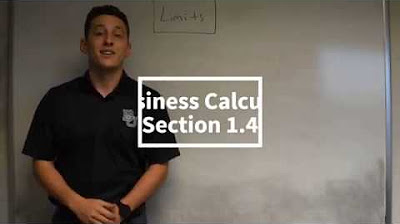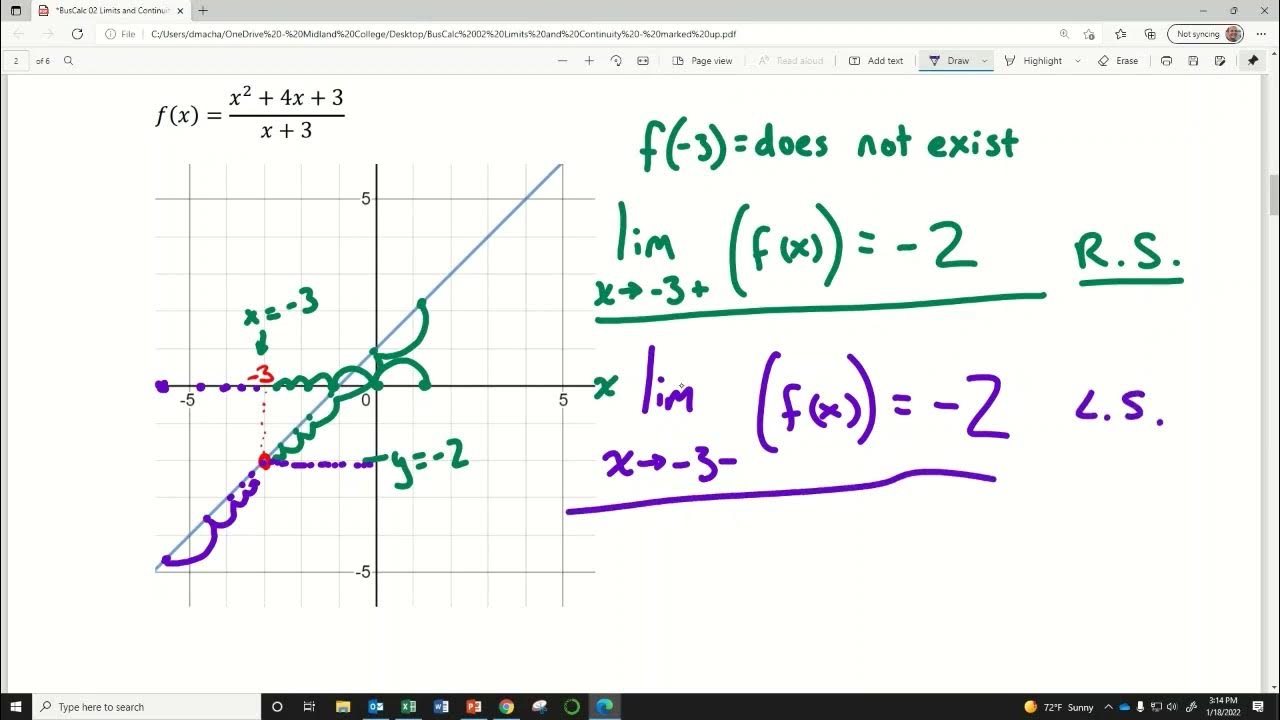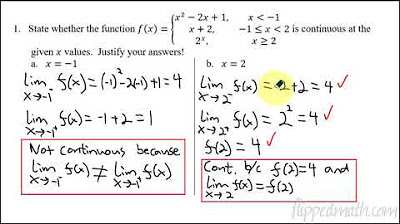Calculus AB/BC - 1.2 Defining Limits and Using Limit Notation
TLDRIn this calculus lesson, Mr. Bean introduces the concept of limits, emphasizing the importance of understanding their graphical representation. He explains that limits describe what a function approaches as the input value nears a specific point, using examples to illustrate how the limit may or may not equal the function's value at that point. The lesson clarifies that limits do not always match the function's value, especially at points of discontinuity, and ends with practice questions to reinforce the concept.
Takeaways
- 📚 The lesson is focused on understanding limits in calculus, with an emphasis on their graphical interpretation.
- 🔍 Limits are about what a function is approaching as the input value (x) gets closer to a specific number.
- 📈 The notation for a limit is described, showing how to write the limit as x approaches a certain value.
- 👉 The limit can sometimes match the function's value at a point, but it can also be different, especially if the function is undefined at that point.
- 🤔 The concept of the limit is distinguished from the actual value of the function at a given point, which may or may not exist.
- 📉 The script provides examples to illustrate how to determine the limit of a function as x approaches a certain value, including cases where the function is undefined.
- 📝 It is clarified that the limit does not always equal the function's value at a point, dispelling a common misconception.
- 👀 The importance of understanding that a limit describes the approach to a value rather than the value itself is emphasized.
- 📚 The lesson introduces the concept of one-sided limits, which will be explored in more depth in a subsequent lesson.
- 📝 Practice exercises are suggested to reinforce understanding, indicating that learners should verify their comprehension through problem-solving.
- 🎓 The lesson concludes with an interpretation statement to help students understand how to express the concept of a limit in everyday language.
Q & A
What is the main focus of Mr. Bean's calculus lesson?
-The main focus of Mr. Bean's calculus lesson is on understanding limits, particularly through the analysis of their graphs.
What does Mr. Bean suggest is the easiest way to understand limits?
-Mr. Bean suggests that the easiest way to understand limits is by first talking about their graphs.
What is the notation used to represent a limit in calculus?
-The notation used to represent a limit in calculus is 'lim' followed by 'as X approaches a certain value' and then the function, for example, 'lim as X approaches 2 of f(X)'.
What does it mean when the limit of a function as X approaches a certain value is given?
-It means that as X gets closer and closer to that certain value, the function approaches a specific Y value.
How does Mr. Bean differentiate between the limit of a function and the function's value at a certain point?
-Mr. Bean explains that sometimes the limit is the same as the function's value at a certain point, but other times it is not, especially when there is an open hole or the function is undefined at that point.
What does Mr. Bean mean by 'approaching from both sides'?
-Approaching from both sides means considering the limit as X gets closer to a certain value from both the left and the right on the number line.
Why might the limit of a function at a certain point be undefined?
-The limit of a function might be undefined if there is no value of the function at that point, such as when there is an open hole in the graph.
What is the difference between a filled dot and an open dot on a graph according to Mr. Bean's explanation?
-A filled dot on a graph represents the value of the function at a specific point, while an open dot indicates that the function is undefined or there is no value at that point.
How does Mr. Bean interpret the statement 'lim as X approaches 7 of f(X) equals 10'?
-Mr. Bean interprets it as 'as X approaches 7, f(X) approaches 10', meaning the function's value gets closer to 10 as X gets closer to 7.
What is the false statement Mr. Bean discusses regarding the equivalence of the function's value and the limit?
-The false statement is that 'F of 1 is equivalent to the limit as X approaches 1 of f(X) in all cases', which is not true because the function's value at a point may not always equal the limit as X approaches that point.
What is the significance of understanding limits in calculus?
-Understanding limits is significant in calculus as they provide insight into the behavior of functions, especially as input values approach certain points, and are fundamental to concepts like continuity and derivatives.
Outlines
📚 Understanding Limits in Calculus
This paragraph introduces the concept of limits in calculus, focusing on the graphical interpretation. Mr. Bean explains limits as the value a function approaches, using the notation for expressing limits and providing examples. He clarifies that the limit may or may not be the same as the function's value at a specific point, highlighting the difference between the two with examples. The paragraph emphasizes the importance of understanding limits as the function's approach to a value rather than its value at a point, and it invites students to practice identifying limits from graphs.
📉 Interpreting Limits Graphically
The second paragraph delves deeper into the graphical interpretation of limits, illustrating how to find the limit by looking at the graph's behavior as it approaches a specific x-value from both sides. It discusses the concept of one-sided limits, which will be covered in a subsequent lesson, and emphasizes the distinction between the limit and the actual value of the function at a given point. The paragraph concludes with an interpretation statement to clarify the meaning of a limit and corrects common misconceptions about the relationship between the function's value and its limit, reinforcing the idea that a limit indicates the approach of a function's value rather than its exact value.
Mindmap
Keywords
💡Limits
💡Graph
💡Function
💡Approaching
💡Y Value
💡Open Hole
💡Undefined
💡One-Sided Limits
💡Mastery Check
💡Precalc
Highlights
Mr. Bean introduces a calculus lesson focusing on understanding limits through their graphs.
Limits are explained as what a function is approaching as an x-value gets closer to a specific number.
The notation for writing a limit is demonstrated with an example where the limit as X approaches 2 is equal to 1.
The difference between the limit and the function's value at a point is clarified with examples.
An example is given where the limit exists but the function is undefined at the point X=2.
Illustration of how to determine the limit when the function is defined at the point of interest.
The importance of distinguishing between the limit and the actual value of the function is emphasized.
A step-by-step guide on how to find limits from graphs is provided for clarity.
Practice problems are introduced to help students understand the concept of limits in calculus.
The concept of one-sided limits is mentioned as a topic for a future lesson.
An interpretation statement is given to explain how to understand the meaning of a limit.
A true or false question is used to test understanding of when the function's value equals the limit.
Examples are provided to show when the function's value at a point does not equal the limit.
The lesson concludes with Mr. Bean summarizing the key points about limits in calculus.
Encouragement is given for students to practice and master the concept of limits.
Mr. Bean signs off, indicating the end of the lesson and looking forward to the next one.
Transcripts
5.0 / 5 (0 votes)
Thanks for rating:





